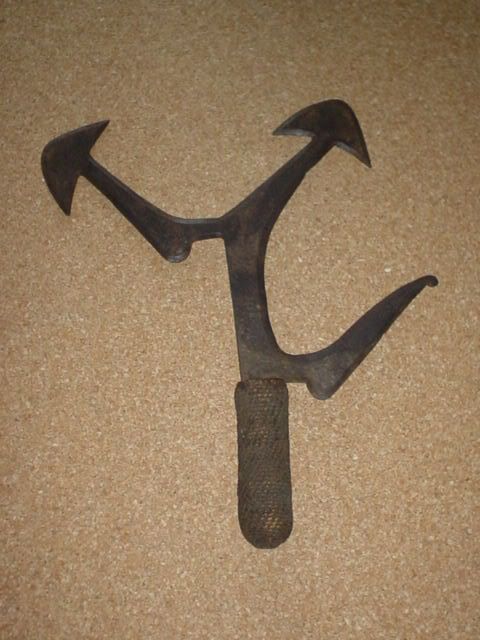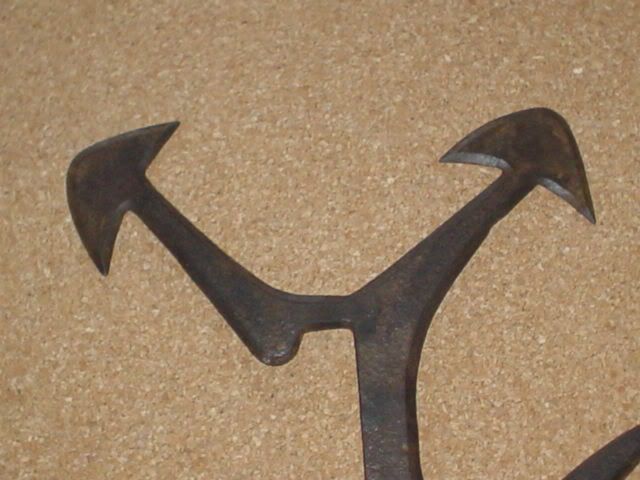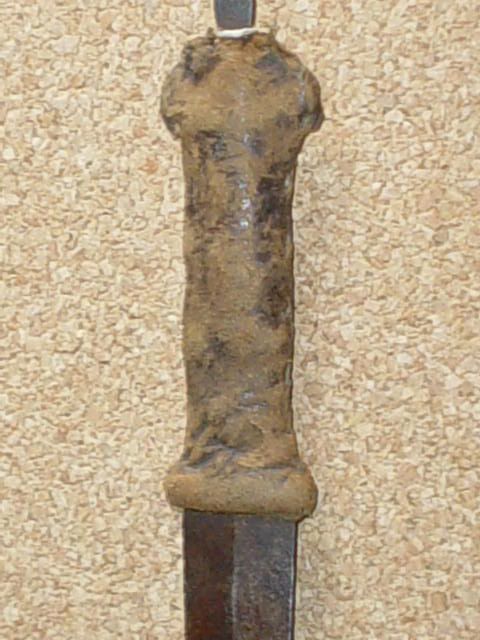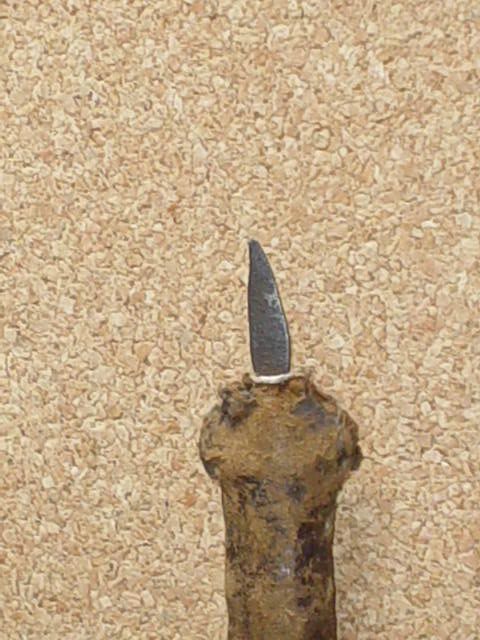
 |
|
|
#1 |
|
Member
Join Date: Dec 2004
Location: Italia
Posts: 1,243
|
Hello.
This is one is my last purchase. Probably is a kuba nshaal knife. The blade is painted for half in white and for the other half in red. All comments are well accepted. Thank you 
|
|
|

|
|
|
#2 |
|
Member
Join Date: Dec 2004
Location: Houston, TX, USA
Posts: 1,254
|
Is the handle woven over with leather, or is it carved that way? What is the use of this item? Is it a ceremonial/costume dagger, as I'm given to understand of ikula? Kind of a mini ilwoon?
|
|
|

|
|
|
#3 |
|
Member
Join Date: Dec 2004
Location: What is still UK
Posts: 5,940
|
Hello, very interesting,what shape is the cross section of the blade?How thick is it?Can you provide a close up where the blade fits the handle?Looks great.Tim
|
|
|

|
|
|
#4 |
|
Member
Join Date: Dec 2004
Location: Italia
Posts: 1,243
|
Hi guys!
Hello Tom, the handle is covered with copper strips with perpendicular cuts. Honestly I don't know the use of this knife but maybe is a ceremonial or dance knife for women. I don't think that in any case is correlated with Ilwoon. Hi Tim, the cross section at the very tip of the blade is flat 3 mm, while where the blade fits the handle there is a middle rib thick nearly 1cm. This picture comes from AFRIKANISCHE WAFFEN of two kuba nshaal, but the blade is quite different. |
|
|

|
|
|
#5 |
|
Member
Join Date: Dec 2004
Location: Houston, TX, USA
Posts: 1,254
|
Interesting. Both the flared tip and the midrib at the base are similar to ilwoon. Ilwoon is a fighting sword, and I suspect this is a ceremonial knife, but it seems to me that some reference is being made. It is tempting to say the whole thing looks like a woman in a dress, but remember A/Central African men wear skirts, as much as women, and B/ in Central Africa swords are usually spoken of the other way around; the handle is hte feet or legs; the tip is the head, and some are even explicitly shaped with divided legs.
|
|
|

|
|
|
#6 |
|
Member
Join Date: Dec 2004
Location: What is still UK
Posts: 5,940
|
I so admire Congo iron work,such fluid forms,the beauty of the easy looking hammer marks reminding one of the red hot softness, all giving the impression that the piece was forged in one heating.Tim
|
|
|

|
|
|
#7 |
|
Member
Join Date: Dec 2004
Location: Italia
Posts: 1,243
|
Hello to both you guys! Maybe you can help me: I have this ilwoon but i'm not sure of the age (before 1940?). The shape of the blade and that of the handle they leave me a little doubtful. What do you think about this?
|
|
|

|
|
|
#8 |
|
Member
Join Date: Dec 2004
Location: What is still UK
Posts: 5,940
|
Hello Flavio, I would think the best one can say is early 1900s.In some areas of collecting most people would poo poo this sort of age but with a lot of pieces from the Congo I consider this to be a good age.A great many people have no idea how isolated and how impassable the country was up untill the mid 20 century and rapidly becoming so again, rather like the lost tribes of the Amazon jungle of more recent times.I include a post of one of my Congo swords
Last edited by Tim Simmons; 27th March 2005 at 08:01 PM. |
|
|

|
|
|
#9 |
|
Member
Join Date: Dec 2004
Location: Sint-Amandsberg (near Ghent, Belgium)
Posts: 830
|
Nice Kuba sword, Flavio. I think Tim is right concerning the age.
A lot of African weapons were still being produced in the middle of the 20th century. Remember that people used to bring axes and knives back from 'the Congo' when they visited their homeland. This is the case in Belgium. Most of the African weapons in my collection date from that time. They 'linger' in the attics until someone discovers them. When looking at your 'ilwoon', I notice some rust. I would advise you to remove the rust gently. I always use a copper brush fixed to my drill. In this way, the rust is easily removed. Afterwards, I put some oil onto the blade. I usually apply oil used for tools. You'll see, your sword will get its black patina again. Here's an example : The first picture shows a Mbanja throwing knife as I bought it. The second one shows the same knife after cleaning   Freddy 
|
|
|

|
|
|
#10 |
|
Member
Join Date: Dec 2004
Location: Italia
Posts: 1,243
|
Thank you very much guys. Hello Freddy, i think that we know each other on ebay some times ago. The pictures of the ilwoon is before that i clean it. Now the rust is eliminated: I clean up the blades with iron wool and oil.
Hi Tim I have a Yaka sword like yours. |
|
|

|
|
|
#11 |
|
Member
Join Date: Dec 2004
Location: What is still UK
Posts: 5,940
|
Wonderfull, this is my favourite Knife.To me it sums up all of that 1960s intelligentsia raved about in African art.Tim
|
|
|

|
|
|
#12 |
|
Member
Join Date: Dec 2004
Location: Italia
Posts: 1,243
|
Great knife, Tim. This is my favourite, a Fang Fa knife from Gabon.

|
|
|

|
|
|
#13 |
|
Member
Join Date: Feb 2005
Location: Clearwater, Florida
Posts: 371
|
Sweet pieces all.
A couple of years ago I bought what I thought was a Yaka short sword and when it arrived, I was somewhat taken aback as the hilt and scabbard atr typically Yakan while the blade is 100% Salampuso. Excuse the photo as the color is considerably off and the rust is long gone......leave it to me to come up with the exception rather than the rule!**grin** When speaking of age in weapons/artifacts from Central Africa, the Amazon basin and New Guinea I personally feel that one has to take a whole different perspective than with those from other regions as there were so many isolated areas that remained unexplored and with populations that were relatively untouched and uncontaminated until well into the middle of the 20th century......an early 1900's piece from some of these regions is often an equivelent to a late 1700's piece from others in regards to tribal "purity". Mike |
|
|

|
|
|
#14 |
|
Member
Join Date: Dec 2004
Location: Italia
Posts: 1,243
|
  What a surprise, Mike! I have a sword with an identical blade like yours, but, untill now, i never seen others! I thought was congolese, but someone said to me that it maybe comes from Cameroon. Instead there are no doubts it comes from Congo as show the tipical yaka handle and scabbard! But Mike, I don't think that the blade is Salampasu, it's quite different! |
|
|

|
|
|
#15 |
|
Member
Join Date: Feb 2005
Location: Clearwater, Florida
Posts: 371
|
I'd hazard a guess that the Ilwoon is actually mid to late 1800's based upon the heavy ridge in the center, with later pieces often much flatter.
The Fang Fa sword is absolutely gorgeous **drool** and Freddy, is your mbanja thrower a user or a ceremonial piece (it looks like the former)as probably 80% of the "throwing knives were actually ceremonial pieces. Flavio, that is a beautiful sword and definitely the same blade, but with a hilt and scabbard style I've not seen before......just great, now I'm back to square one again, but at least not alone this time! LOL! Many don't realize that a lot of tribes were actually quite fluid, moving as alliances were made or broken and with many "tribes" actually part of much larger nations, much like the American plains Indians, the African Zulu nation tribes prior to Chaka or even the Mongols prior to Temujen's unification, to go way back. Here's my latest thrower, a Ngbaka (I believe) user type that ironically was reproduced and mass marketed here in the US about 10 years ago as the "hunga munga"...I wish I'd have kept the US version now more than ever, but alas it was thrown to death!**grin** Mike |
|
|

|
|
|
#16 |
|
Member
Join Date: Dec 2004
Location: Italia
Posts: 1,243
|
Hello Mike, great throwing knife (even if I preferr to call it throwing blade since here in Italy, and maybe also in other countries, the knife is something very different: a blade with only one edge sharp).
Anyway, about your yaka short sword, I have said previously that the blade, in my opinoin isn't salampasu, (is for the working of the blade, mine is all hammered in the central part, while the salampasu that are mine are completely smoothed, more the midrib is decorated with a zig-zag, while the salampasu blades are not or, maximum, they have a series of dots that close encircles the depression near the hilt [in mine, and as i can seen, in your blade there isn't this depression]). After all i'm agree on what you say about the several African tribes. Perhaps the single comparison with salampsu is on the scabbard of my short sword: it has, like the salampasu scabbard, that element in relief that help to hang the scabbard to the sides or on the back. |
|
|

|
|
|
#17 |
|
Member
Join Date: Dec 2004
Location: What is still UK
Posts: 5,940
|
Hello all, I have seen Mikes Knife with the Yaka style hilt and scabbard but Cameroon style blade labeled as Songye.I think one has to except some cross over of stylistic boundarys.However I agree with Flavio that I to feel it is not Salampasu, which I believe this is.Tim
|
|
|

|
|
|
#18 |
|
Member
Join Date: Dec 2004
Location: Sint-Amandsberg (near Ghent, Belgium)
Posts: 830
|
I'm starting to like this thread. Let's all show our 'strange' knives and swords.
Mike, The Mbanja throwing knife could be ceremonial if you look at its shape. But I can assure you : all edges are sharp. It came in a lot with four other throwing knives. All from the same region, but all with a different shape. I guess the other four are more for 'daily' use. I wouldn't like to be in the flight path when these guys are thrown. All are still sharp. One thing is sure, a throwing knife made to be used always has a plaited or leather handle (sometimes copper banding is also used). Other material would break on impact. The ones with wooden or even ivory handles are the ceremonial ones. This is how I found them :  Look at the edges :  One even has some engravings  By the way, Mike : nice throwing knife. Why not throw it at me 
|
|
|

|
|
|
#19 |
|
Member
Join Date: Dec 2004
Location: What is still UK
Posts: 5,940
|
Very nice Freddy,have you got one spare?
|
|
|

|
|
|
#20 |
|
Member
Join Date: Dec 2004
Location: What is still UK
Posts: 5,940
|
I know I am going up North ,I just had to join in one more time.Afene.Tim
|
|
|

|
|
|
#21 |
|
Member
Join Date: Feb 2005
Location: Clearwater, Florida
Posts: 371
|
I stand corrected on the Salampasu attribution and agree with you guys, particularly after seeing your fine examples.
Mine is definitely a user piece with a raised central rib that's nicely decorated and incised and then is depressed on either side thikening slightly to a reinforced cutting edge that's razor sharp...I'll clean it and post a better blade photo. Freddy, those throwers are awesome and highly effective and lethal, real beauties....as I said, I had a US mass produced cheap and thinner version and practiced with it until I literally destroyed it, but it was amazingly accurate and almost always struck true, thus giving me a real appreciation for them as both weapons and hunting tools for small game. Your observation of the ivory and elaborate hilts on throwers would seem to indicate that they also have some prestige value, much like Moro swords from the Philippines more than ceremonial, but I agree, those weren't for everyday use. Tim, I have one similar to your favorite, only without the widened extension as a pommel...is that one metal or wood? I've seen one or two with that same hilt and from the photos it almost looked like at least one had a secondary blade for a pommel, perhaps as a built in fleshing tool? I also agree on posting away as African pieces seem to take a back seat so often, with many truly impressive. Justin originally thought the African pieces looked flimsy until I let him split a log with one!**grin** Mike |
|
|

|
|
|
#22 |
|
Member
Join Date: Feb 2005
Location: Clearwater, Florida
Posts: 371
|
Sweet Tim...that's one often pictured but relatively rarely seen.
I'm getting more and more envious as this thread goes on. Mike |
|
|

|
|
|
#23 |
|
Member
Join Date: Dec 2004
Location: Italia
Posts: 1,243
|
Hey guys this thread it's great!! What a gallery of very beautiful pieces!!
And Tim, your salampasu sword it's simple woderfull!! The scabbards is decorated with some shells? |
|
|

|
|
|
#24 |
|
Member
Join Date: Feb 2005
Location: Clearwater, Florida
Posts: 371
|
Those are cowie shells, something that I find extremely interesting as they are used as decoration throughout Africa, even in arrid regions hundreds of miles inland, throughout Indonesia and the Philippines and even on many Native American artifacts, making it probably one of the most universally used decorative items in the world.
Although some cowries reach 4" in size, the vast majority are too small to have any value EXCEPT as decor, making it all the stranger. Mike |
|
|

|
|
|
#25 |
|
Member
Join Date: Feb 2005
Location: Clearwater, Florida
Posts: 371
|
Here's two Turkana pieces, just for example, and yes, I KNOW they aren't knives!**grin**
Mike |
|
|

|
|
|
#26 |
|
Member
Join Date: Dec 2004
Location: Sint-Amandsberg (near Ghent, Belgium)
Posts: 830
|
Nice dress, Mike. On what occasion do you wear it ?
 Now for some serious business. Here's an odd one. All I know about it that it came from Cameroon. It has a vicious spike on the handle. Has anyone seen something like this yet ?    
|
|
|

|
|
|
#27 |
|
Member
Join Date: Feb 2005
Location: Clearwater, Florida
Posts: 371
|
That's a first with a pommel spike, although the rest of it appears to be jambya inspired with similar found throughout regions with a large Muslem population to the extent that further identification would seem very difficult.
As to the "dress"**grin**, it's a male sash and the female form was solely for photo purposes. Let's just say it's a LOT of fun to open the door on Holloween and watch kids scatter in all directions..... Ive even had a mom or two slightly taken aback! LOL! Mike |
|
|

|
|
|
#28 |
|
Member
Join Date: Dec 2004
Location: What is still UK
Posts: 5,940
|
I imagine this just shows the extent of Arab influence as illustrated in that wonderful book De fer et de fierite'.Tim
|
|
|

|
|
|
#29 |
|
Member
Join Date: Feb 2005
Location: Clearwater, Florida
Posts: 371
|
Tim, sorry to bother you, but again, is the pommel end on the Ngandu sword iron or wood?
After viewing it repeatedly, I almost wonder if the dowel-like end on mine isn't made to insert into another, more decorative pommel to be complete? Mike |
|
|

|
|
|
#30 |
|
Member
Join Date: Dec 2004
Location: What is still UK
Posts: 5,940
|
Hi Mike, talking and looking at Congo Knives is not bother it is a delight.I hope these pictures explain themselves.I try to keep the typing to a minimum because I can only one and a half finger type, which is an improvment on just one.Tim
|
|
|

|
 |
| Thread Tools | Search this Thread |
| Display Modes | |
|
|